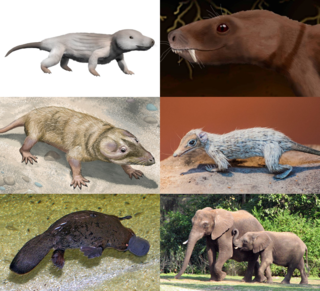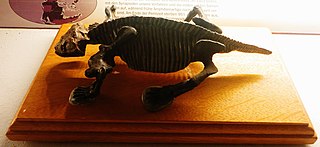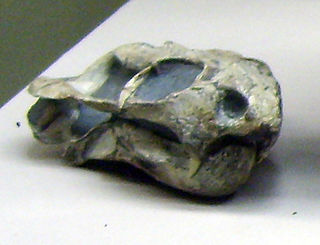
Synapsids are one of the two major groups of animals that evolved from basal amniotes, the other being the sauropsids, the group that includes reptiles and birds. The group includes mammals and every animal more closely related to mammals than to sauropsids. Unlike other amniotes, synapsids have a single temporal fenestra, an opening low in the skull roof behind each eye orbit, leaving a bony arch beneath each; this accounts for their name. The distinctive temporal fenestra developed about 318 million years ago during the Late Carboniferous period, when synapsids and sauropsids diverged, but was subsequently merged with the orbit in early mammals.

Therapsida is a major group of eupelycosaurian synapsids that includes mammals, their ancestors and relatives. Many of the traits today seen as unique to mammals had their origin within early therapsids, including limbs that were oriented more underneath the body, as opposed to the sprawling posture of many reptiles and salamanders.

The cynodonts are a clade of eutheriodont therapsids that first appeared in the Late Permian, and extensively diversified after the Permian–Triassic extinction event. Cynodonts had a wide variety of lifestyles, including carnivory and herbivory. Mammals are cynodonts, as are their extinct ancestors and close relatives, having evolved from advanced probainognathian cynodonts during the Late Triassic. All other cynodont lines went extinct, with the last known non-mammalian cynodont group, the Tritylodontidae, having its youngest records in the Early Cretaceous.

Caseasauria is one of the two main clades of early synapsids, the other being the Eupelycosauria. Caseasaurs are currently known only from the Late Carboniferous and the Permian, and include two superficially different families, the small insectivorous or carnivorous Eothyrididae, and the large, herbivorous Caseidae. These two groups share a number of specialised features associated with the morphology of the snout and external naris.
Admetophoneus is a dubious genus of non-mammalian synapsid from Russia. Its type and only species is Admetophoneus kargalensis.

Daptocephalus is an extinct genus of non-mammalian synapsid anomodont dicynodont, it which was found in Late Permian strata, in a biozone known precisely for the presence of fossils of this dicynodont, the Daptocephalus Zone, in the Karoo Basin in South Africa. An additional species, D. huenei, is known from the Usili Formation in Tanzania and was formerly assigned to the genus Dicynodon before a study in 2019 recognised that the type specimen belonged to Daptocephalus.
Eosyodon is a dubious genus of extinct non-mammalian synapsids from the Permian of Texas. Its type and only species is Eosyodon hudsoni. Though it was originally interpreted as an early therapsid, it is probably a member of Sphenacodontidae, the family of synapsids that includes Dimetrodon.
Elliotsmithia is a small varanopid synapsid found from the late Middle Permian of South Africa. It is the sole basal synapsid "pelycosaur" known from the supercontinent Gondwana and only two specimens have been yielded to date. Its species name longiceps is derived from Latin, meaning "long head". Both known Elliotsmithia fossils were recovered from Abrahamskraal Formation rocks—within the boundaries of the Tapinocephalus Assemblage Zone—of the lower Beaufort Group. It was named for the late Sir Grafton Elliot Smith in 1937.
Ictidognathus is an extinct genus of therocephalian therapsids that lived in South Africa during the Late Permian. Fossils are found in the Tropidostoma and Cistecephalus Assemblage Zones of the Beaufort Group in the Western Cape.

Kawingasaurus is an extinct genus of dicynodont therapsid from the Late Permian Usili Formation of Tanzania. It is a member of the family Cistecephalidae, and like other cistecephalids it is thought to have been fossorial.
Knoxosaurus is an extinct genus of non-mammalian synapsids containing the species Knoxosaurus niteckii that existed approximately 279.5 to 268 million years ago. It was named by American paleontologist Everett C. Olson in 1962 on the basis of fragmentary fossils from Middle Permian-age deposits in the San Angelo Formation of Texas in the United States. Olson placed Knoxosaurus in a new infraorder called Eotheriodontia, which he considered a transitional group between the more reptile-like "pelycosaurs" and the more mammal-like therapsids. Knoxosaurus and Olson's other eotheriodonts were later considered to be undiagnostic remains of basal synapsids, no more closely related to therapsids than are other pelycosaur-grade synapsids.
Mastersonia is an extinct genus of non-mammalian therapsids from the Lower Permian of San Angelo Formation, Texas. It is only known from a few, very large vertebrae.
Molybdopygus is an extinct genus of estemmenosuchid dinocephalians from the Middle Permian of Russia. It is known from a single pelvis.
Milosaurus is an extinct genus of non-mammalian synapsids native to Illinois that was alive during the latest Carboniferous and earliest Permian. It was named in 1970 on the basis of FMNH 701, a partial skeleton.
Oromycter is an extinct genus of caseid synapsids from the Early Permian of Oklahoma. The sole and type species, Oromycter dolesorum, was named in 2005 by Robert R. Reisz.

Pristerodon is an extinct genus of dicynodont therapsid from the Late Permian of South Africa, Zambia and India.
Watongia is an extinct genus of non-mammalian synapsids from Middle Permian of Oklahoma. Only one species has been described, Watongia meieri, from the Chickasha Formation. It was assigned to family Gorgonopsidae by Olson and to Eotitanosuchia by Carroll. Reisz and collaborators assigned the genus in Varanopidae.

Ulemica is an extinct genus of venjukoviid therapsids. It was a basal member of the suborder Anomodontia that existed during the Middle Permian in Russia. The type species, U. invisa, was assigned to the genus Venjukovia prior to being placed within its own genus in 1996. This small anomonodont is only known from a partial skull found in the Amanakskaya Formation.

Eutheriodontia is a clade of therapsids which appear during the Middle Permian and which includes therocephalians and cynodonts, this latter group including mammals and related forms.

Shashajaia is a genus of extinct non-mammalian synapsids from the late Carboniferous to Early Permian. It was one of the earliest members of the group, coming from the Gzhelian stage. It lived in what is now the Halgaito Formation within the larger Cutler group located in the U.S state of Utah. According to a description study, this synapsid is known from well preserved dentary and jaw fragments. Shashajaia shares many similarities to other sphenacodontids including, enlarged (canine-like) anterior dentary teeth, a dorsoventrally deep symphysis and low-crowned, subthecodont postcanines having festooned plicidentine. The study also found that this genus is close to the evolutionary divergence of the Sphenacodontids and the Therapsids, from which mammalian synapsids arose from. Based on studies done on its teeth, Paleontologists found that as their prey became more terrestrial, synapsids like Shashajaia adapted to life on land and grew larger teeth to deal with larger herbivores in a evolutionary arms race.














